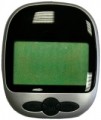Mount
—
Wrist. Worn on the wrist like a traditional watch, many models of these devices closely resemble electronic watches. This method of attachment is highly convenient, especially for heart rate monitors, as the device sits directly on the skin, allowing for easy integration of pulse sensors. However, for pedometers, wrist mounting has drawbacks due to various vibrations affecting accuracy. To compensate, devices require intricate accelerometer calibration or the use of a GPS module, both influencing the device's cost.
—
Forearm. Placing the sensor on the forearm (parts of the arm from the elbow and above) is both easier and less inconvenient. However, the distance of the sensor from the heart can affect the accuracy of the measurement. Therefore, most of the cardio sensors are made exactly on the chest (see paragraph above).
—
Chest. Secured on the chest with a specialized belt, this method positions the device close to the heart, ensuring highly accurate heart rate tracking. However, devices with this setup typically lack displays as checking them would be inconvenient. This configuration is exclusively employed in cardiac sensors (see "Type").
—
Neck. Traditionally, these devices are attached to a cord or ribbon for wearing around the neck. While this is the standard method, many models offer versatility,
...allowing them to be placed in a pocket. Some devices in this category are not designed for cord attachment at all and are somewhat loosely classified. Pedometers are commonly found in the "neck" device category.
— Shoes. Positioned on the upper part of shoes, typically where lacing is found in classic sneakers, this method is convenient for pedometers, ensuring accurate step tracking. However, it may not be compatible with all shoes, and using certain functions can be challenging, requiring bending over or removing the device to interact with the display. As a result, this option hasn't gained widespread popularity.
— Fastening with a clip. Featuring a universal clip or "clothespin" in its design, this allows the device to be easily attached to the edge of clothing, such as a belt, collar, or pocket. Common in classic pedometers (see "Type"), these devices don't require direct contact with the skin during operation. The clip attachment method is more versatile than mounting on shoes and, for some users, is even more convenient than wearing the device around the neck or on the wrist/shoulder.
There are models that have several purposes — usually, these are devices on wrist, supplemented with alternative options (for example, a clip).Features
—
Clock. Classic clock — a function of displaying the current time.
The clock provides not only time tracking, but also some other features — for example, they are mandatory for devices with an alarm clock (see below).
—
Alarm clock. The presence in the device of the alarm clock function — the sound signal at a specified time. In the simplest models, this signal can only be programmed for one specific time, more advanced devices allow you to remember several alarms, and if you have a calendar (see below), you can also set them on certain days (for example, only on weekdays or even on specific dates) .
—
Calendar. The device includes a calendar function, displaying at least the current date, and some models may offer advanced features like viewing monthly dates in table form. Calendar data is often used by other functions, ranging from the built-in training diary to the alarm clock.
—
Stopwatch. The device can function as a stopwatch, measuring time intervals with high accuracy, down to tenths or even hundredths of a second. The
stopwatch starts and stops at the user's command, and many models offer special measurement modes, including recording intermediate results or the time of each individual lap. This makes stopwatches significantly mor
...e convenient for measuring time intervals than regular watches.
— Timer. The ability to operate the device as a timer — that is, in the countdown mode, with a signal at the end of the specified segment. This feature will be useful when performing exercises that are clearly limited in time: setting a timer and waiting for a signal is more convenient than constantly looking at the clock.
— Lap counter. The device has the capability to record data (time, speed, calories burned, average heart rate, etc.) for each individual lap, such as during running. Typically, this is achieved with a designated "Lap" button that, when pressed, captures data for that lap and initiates a new countdown. This function enables monitoring of training dynamics, identifying the most effective laps, while simultaneously recording overall training data. Some devices also offer a lap countdown feature, where the user sets a specific number of laps, and the device signals the end of the workout after that set number is completed. This simplifies the process of tallying the total number of laps.
— Multisport. The device includes a "multisport" function designed to enhance usability during multisport activities — training or competitions involving various sports stages. While non-specialized devices can be used for such activities, those with the dedicated "multisport" feature offer greater convenience. Optimized for this mode of use, they feature built-in software modes like "Running" or "Rowing" that can be easily switched between. These devices save complex data in a format conducive to further processing and analysis.Built-in memory
The device has
its own built-in memory.
Almost every sophisticated electronic device has a certain amount of memory, but here we specifically refer to permanent memory. This type of memory is ideal for long-term data storage, ensuring information is retained even during power outages. Its presence enables the device to operate autonomously, storing training logs, individual settings, and other essential data without the need for communication with other devices.

